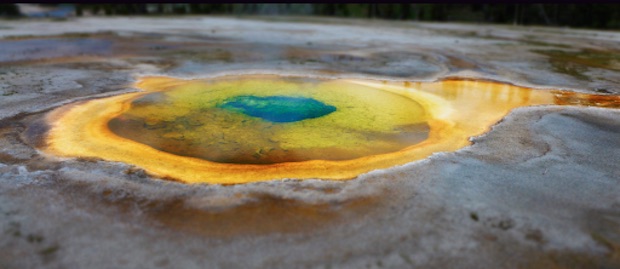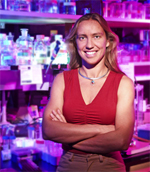Enzyme Evolution
By creating a model of a 3-billion-year-old enzyme in her lab, biochemist Dorothee Kern unraveled a mystery about how life began on the planet.
 Julia Kern
Julia KernIllustration of a hot spring in Yellowstone National Park. The color gradient from green via yellow to orange and brown reflects bacteria surviving at a range of temperatures. Life on earth likely started several billion years ago in a hot environment, just like the center of the hot spring.
Some three billion years ago, when life on this planet was still in its infancy, hot springs, geysers and volcanic hydrothermal vents were burgeoning with single-cell organisms. Temperatures hovered around a burning hot 180 degrees. In a few hundred million years, the basic elements of our genetic code and cellular machinery all came into being.
Then it started to get colder. Standing on the equator 1 billion years ago, it would have been as cold as today's Antarctic.
 Of course this story has a happy ending — life developed anyway — but how it managed to adapt to the earth’s cooling remains something of a mystery. Now, in the cover story of the January 20 issue of Science, Professor of Biochemistry Dorothee Kern offers an explanation as to how enzymes — key catalysts in cells — braved the cold. "It's one more clue to how life evolved on this planet," she says.
Of course this story has a happy ending — life developed anyway — but how it managed to adapt to the earth’s cooling remains something of a mystery. Now, in the cover story of the January 20 issue of Science, Professor of Biochemistry Dorothee Kern offers an explanation as to how enzymes — key catalysts in cells — braved the cold. "It's one more clue to how life evolved on this planet," she says.
Kern, a prestigious Howard Hughes Medical Institute Investigator (and one-time champion East German basketball player), began working five years ago on building replicas of ancient, extinct enzymes. By analyzing the genetic code of thousands of species of bacteria, her team created an evolutionary tree then worked backwards to infer the structures of an enzyme called adenylate kinase (ADK) from three billion years ago up to its modern forms. ADK is present in every living creature on the planet.
In her lab, Kern’s team studied the behavior of this enzyme across a wide range of temperatures, essentially reenacting several billion years' worth of evolution in a few days. What she found was that over time, ADK underwent genetic mutations so that it could swap out a key component, namely amino acids. This enabled it to cope with the inevitable loss of energy due to the decrease in environmental temperatures. As a result, ADK remained highly active despite the energy loss.
Kern created what she calls a "super-enzyme," an ADK able to survive in both hot and cold climates. It was a transitional molecule as life adapted to the changing environment.
The existence of such a super-enzyme disproves a long-held theory that increased enzyme activity is counterbalanced by a decreased chemical stability. Kern's lab's super-enzymes were highly active, yet didn't grow more unstable. It appears enzymes are a lot more adaptable than previously thought.
The other authors on the paper were Brandeis graduates students Vy Nguyen, Christopher Wilson, Marc Hoemberger and John B. Stiller; postdoctoral fellow Steffen Kutter; former postdoctoral fellow Roman V. Agafonov; associate professor of biochemistry Douglas L. Theobald; and summer research assistant Justin English.
Categories: Research, Science and Technology





